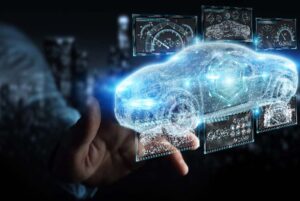 The Automotive industry is at the cusp of technological revolution with the convergence of electric vehicles (EV) and autonomy poised to reshape transportation. This combination can be given the acronym ‘Green and Safe’, which in future will change the way we commute, transform cities and enhance our lives.
The Automotive industry is at the cusp of technological revolution with the convergence of electric vehicles (EV) and autonomy poised to reshape transportation. This combination can be given the acronym ‘Green and Safe’, which in future will change the way we commute, transform cities and enhance our lives.
Below are enlisted some of the key challenges and advantages:
- Enhancing safety and efficiency: With advanced sensors and artificial intelligence, Autonomous EV’s can anticipate and react to situation and hazards much quicker and more accurately than humans react. There is more data available, with sensors around the vehicle, to make decision than what a human has. Also with electric powertrain, we have more precise control on acceleration and braking. However, the long-term vision is to have SAE level L4 and L5 autonomous electric vehicles with a vision of smart mobility and ultimate road safety, in immediate and near future standardization of safety features (SAE L0-L2) like Autonomous Emergency Braking (AEB), Intelligent Speed Assistance (ISA), Emergency Lane Keeping Assistance (ELKA), driver drowsiness and attention warning, reverse detection will be key to enhance safety and reduce road accidents. Legislations like GSR2 in EU are leading the way in ensuring this but irrespective of regulations government, vehicle safety regulators around the world working with automakers should find ways to provide these features as standards in all passenger vehicles overcoming cost barriers. Safety should not be a ‘Choice’ or ‘Configuration’ in modern world.
- System engineering: Though the EV architecture is now quite mature, fully autonomous development cycle sometimes struggles to have a robust system engineering backbone. Contributor to this is the absence of defined standards\regulations and defining a way to have well defined system and functional requirements with AI defined autonomous stacks. Industry is finding solutions but with products now on road this has now become a necessity.
- Sensor technology and integration: Autonomous vehicles rely on various sensors, such as Lidars, cameras, radar and ultrasonic sensors. Industry is seeing key players using different combinations to achieve this for e.g., camera and radar or lidar, camera and radar but all have a challenge of integrating data from multiple sensors effectively and provide it to perception and localisation. Industry is also working hard on increasing the accuracy of the sensors as with fully autonomous it has to be always accurate.
- Motion planning and control: In this layer of autonomous stack, the algorithm needs to make complex decisions based on the available data and learning. Developing algorithms and models that can handle real time decision making, handle dynamic environment and optimize actions considering various constraints is a major challenge. We do have key players today who have successfully showcased autonomous capabilities even in busy cities but there are always those corner cases, which are hard to predict and test. Hence, the current trend is to test as much as possible in simulation. Though software in loop, model in loop testing is very effective, industry needs to also widely incorporate full vehicle level hardware in loop environment to test end to end in a lab environment.
- Battery Technology: Currently there is a lot of focus on enhancing battery technology with some of the key measures as improving energy density, increasing battery lifespan and enhancing safety. This will also improve the range, which will be key in the world of Autonomous and Electrified. With concepts like shared mobility and robo-taxis we envision our electric vehicle to be moving continuously most part of the day.
- Infrastructure challenges: Both Electric and fully Autonomous vehicle bring with them unique infrastructure challenges. We need a robust and widespread charging network incorporating intelligent charging stations, which will interact with autonomous vehicles. Fully autonomous have key challenges which include well maintained and properly marked roadways, detectable road and traffic signs, communication infrastructure to enable vehicle to vehicle infrastructure communication, mapping and localization. Achieving this would of course take time but important is to keep believing in the technology and keep working with authorities around the world to get the infrastructure commitments.
- Legal and ethical challenges for Autonomous: Introduction of fully autonomous vehicles requires the development of comprehensive legal and regulatory framework that addresses issues such as liability, safety standards and operational guidelines. Clear regulations and policies need to be established to ensure safe operation of autonomous vehicle and define responsibility of manufactures, operators and users.
Ethical challenges need to be addressed as well. Clear guidelines and regulations are necessary to govern the behavior of autonomous systems ensuring safety, privacy and ethical decision making in critical situations. Automakers and regulators have to work together to define and implement industry standards that strike a balance between innovation and societal expectation.
To conclude, marriage of Autonomous and Electric Vehicles represents a pivotal moment in the evolution of transportation. With environmental benefits of EV and safety benefits of autonomy, we can envision a future, which is safer, more sustainable and accessible to all. However, realizing this vision will be a close-knit team effort between automakers, policymakers and infrastructure developers. As we embark on this journey, it is important to remain vigilant, collaborative and forward thinking to unlock the full potential of autonomy in electric vehicles and shape a brighter future for mobility.
